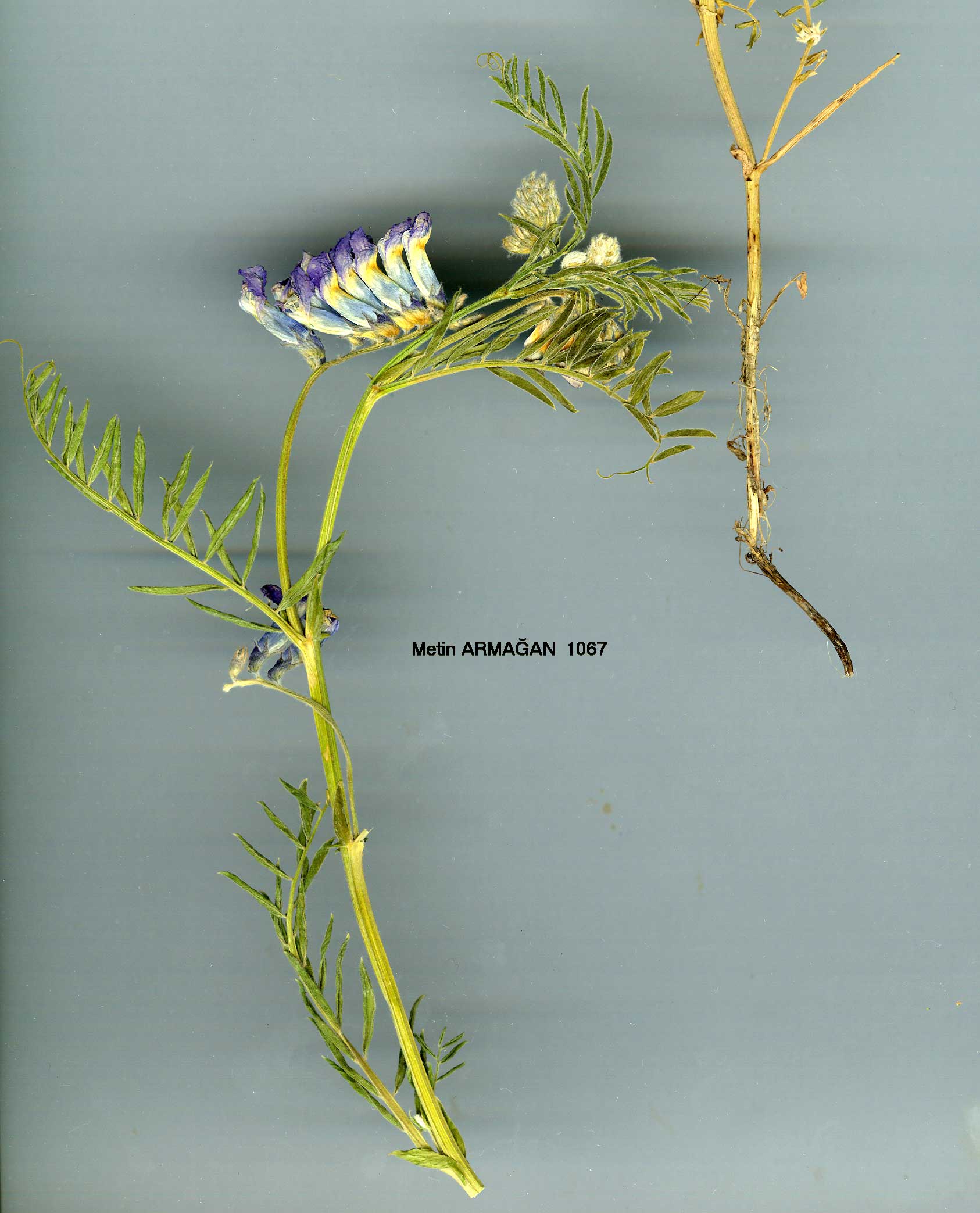| V. canescens Lab., Icon. PL Syr. 1:17, t. 7 (1791). Map 59, p. 285.
Sturdy perennial, 12-80 cm, erect or ascending, sparsely to very densely hairy, subcanescent to sericeous. Leaves with or without tendrils; leaflets 5-12-paired, 5-40 mm, elliptic to linear-lanceolate; stipules semi-hastate, entire. Racemes closely 3-18-flowered, long-peduncled. Flowers large, 17-25 mm, lilac, or violet-blue. Calyx 6-13 mm, scarcely gibbous, purplish, lowest tooth half as long as the tube to about as long. Style dorsally compressed. Legume oblong, 26-35 x7-ll mm, densely adpressed-villous, -pilose or -pubescent, or glabrous with ciliate sutures, several-seeded.
V. canescens is treated here as a polytypic species, remarkable for the variation in the indumentum of its legumes, even within some of its subspecies. Subsp. serinica (Uechtr. & Huter) Davis, t is confined to Italy.
1. Plants adpressed-villous-tomentose, silvery; legume densely adpressed-villous:
leaves with or without tendrils
2. Upper leaves with or without a short simple tendril; stipules 1-2 x as wide as
the stem
3. Stems 25-35 cm: leaflets 10-40 mm, linear-oblong, mostly obtuse; racemes 6-10-flowered subsp. canescens
3. Stems 12-15 cm; leaflets 5-15 mm, elliptic-lanceolate, acute; racemes 3-5-flowered subsp. argaea
2. Upper leaves with a well-developed simple or 2-3-sect tendril; stipules narrower than the stem or as broad subsp. leucomalla
1. Plants pilose, greenish or canescent; legume densely adpressed-pilose, pubescent, or glabrous with ciliate sutures: leaves with tendrils
4. Stems 3.5-5 mm diam., stout, straight and fistulose: stipules 1-3 x as broad as stems subsp. latistipulata
4. Stems 1.5-3 mm diam., straight or flexuous, ± solid; stipules narrower than the stem or as broad
5. Leaflets all ± linear-lanceolate, those of the lower leaves less acute than those of the upper leaves; stems erect or ascending-erect; tendrils mostly simple subsp. gregaria
5. Leaflets of the lower leaves obovate-oblong, obtuse or retuse, shorter than
those of the upper leaves which are elongate and acute; stems flexuous-
erect; tendrils mostly 2-3-sect subsp. variegata
*V. canescens Lab. subsp. serinica (Uechtr. & Huter) Davis, comb. et stat. nov. Syn:
V. serinica Uechtr. & Huter in Öst. Bot..Zeitschr. 55:81 (1905). This S. Italian population fails well within the morphological range of V. canescens sensu lato as accepted here
Subsp.gregaria (Boiss. & Heldr.) Davis, comb. et stat. nov. Syn: V. gregaria Boiss. & Heldr. in Boiss., Diagn. ser. 1(9): 121 (1849)! V. armena Boiss., Diagn. ser. 1(9): 121 (1849)! V. persica Boiss. var. stenophylla Boiss., Fl. Or. 2:583 (1872)! Ic: Náb. in Publ. Fac. Sci. Univ. Masaryk Brno 35: t. 9 (1923). Fl. 7-8. Rocky slopes, 1800-2400 m, colouring the hillsides.
Type: [Turkey C4 Antalya d. Alanya] in regione superiori montis Gheidagh (Geyik Da.) Tauri Isaurici, 1520-2130 m, Heldreich (K! E!).
S. & E. Anatolia. Armenia, Aucher 4364 (type of V. persica var. stenophylla)! B8 Muş:Bingöl Da.nr. Gumgum, 1830-2134 m, Kotschy 362 (type of V. armena)! C4 Içel: Çamurlu Y., between Ermenek and Anamur, 2100 m, D. 16264! Antalya: Geyik Da., 2400 m, D. 14515! C5 Niğde: Cilician Taurus above Bulgar Maaden, Bal.
Soviet Armenia, N. Iraq, N. & N.W. Iran? Ir.-Tur. element. |
 DAVIS_jpg.jpg)

 DAVIS_jpg.jpg)
